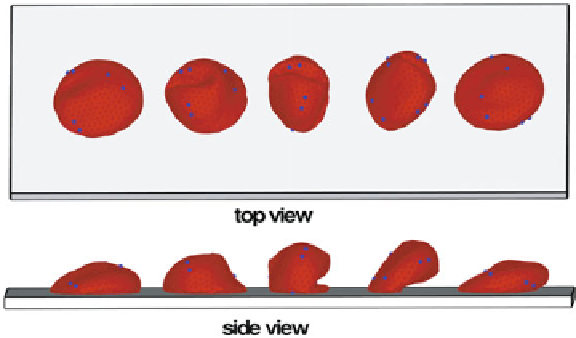Biomedical Engineering Reference
In-Depth Information
80
80
Experiment − Ring
−
stage infected
Simulations − Ring−stage
Experiment − Ring−stage infected
Simulations − Ring−stage infected
60
60
40
40
20
20
0
0
0
0.1
0.2
0.3
0.4
0.5
0.6
0.7
0.8
0
0.1
0.2
0.3
0.4
0.5
0.6
0.7
0.8
Pressure (Pa/
m)
Pressure (Pa/
m)
(a)
μ
(b)
μ
Fig. 10.20.
Average velocity of ring-stage malaria infected RBCs as a function of pressure gradient
and comparison of simulation and experimental results. Results for converging (a) and diverging
(b) geometries (from [67])
10.5.1.3 Pf-RBC adhesive dynamics
Here, we present typical results for the adhesive dynamics of Pf-RBCs in shear flow
for various values of the wall shear stress (WSS). The models employed are de-
scribed in Sect. 10.2.3.5 with some modifications in order for the simulated RBC dy-
namics to be comparable with that found in experiments [81] using purified ICAM-1
as a wall coating. Fig. 10.21 shows several successive snapshots of a cell rolling on
the wall for the schizont stage of a Pf-RBC. The dynamics of the Pf-RBC is char-
acterized by a “flipping” behaviour initiated first by the cell peeling off the wall
due to the force of the hydrodynamic flow after flat RBC adhesion (the first snap-
shot in Fig. 10.21). After the majority of the initial cell contact area with the wall is
peeled off, a RBC flips over on its other side which is facilitated by the remaining
Fig. 10.21.
Top and side views of successive snapshots of a single flipping of an infected RBC at
the schizont stage. Coordinates along the wall for different snapshots are shifted in order to separate
them for visual clarity. Blue particles are added as tracers during post-processing to illustrate the
membrane dynamics (from [51])



























































